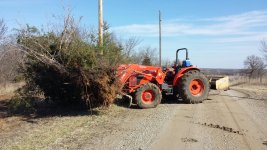oosik
Epic Contributor
Oldtink,
Yes, that is exactly the case. That's what made the calc's I have, somewhere, so unbelievably complicated. The calc's had the FEL as a lever and the fulcrum point on the tractor body was an extremely important determination as was the fulcrum point of the 3-point. What took me so darn long to figure it out a couple years ago was they went so far beyond my understanding. I just plugged in numbers until the outcome looked "nice". Later my son looked at it and he wondered how I had figured it out. He actually understood it - I never told him that I just kept plugging in different lengths & measurements.
Yes, that is exactly the case. That's what made the calc's I have, somewhere, so unbelievably complicated. The calc's had the FEL as a lever and the fulcrum point on the tractor body was an extremely important determination as was the fulcrum point of the 3-point. What took me so darn long to figure it out a couple years ago was they went so far beyond my understanding. I just plugged in numbers until the outcome looked "nice". Later my son looked at it and he wondered how I had figured it out. He actually understood it - I never told him that I just kept plugging in different lengths & measurements.

